Review for Paniponi Dash: Volume 2 - Girls 'n' Roses
Introduction
It's onwards and upwards to the second volume of Paniponi Dash. They say that beauty is in the eye of the beholder. I don't know who they are, nor what beauty they behold to say such a thing, but it's nothing compared to comedy, which truly is in the eyes, and ears of the beholder. What you laugh at depends solely on you, which makes reviewing comedy DVDs an even more subjective process than usual. When I watched the first volume of Paniponi Dash, I found it to be a bit of alright. Nothing special, which was odd given its SHAFT credentials, as I have enjoyed Negima!?, Moon Phase and Natsu no Arashi greatly, shows which definitely tickled my funny bone. But it is a high school comedy, and I have in Azumanga Daioh a ludicrously high benchmark to compare it with. Let's give it another dose of unrealistic expectation, with five more episodes to evaluate.
Rebecca Miyamoto is an MIT graduate who is returning to Japan to teach at Momotsuki (Peach Moon) Academy. She'll be the homeroom teacher to class 1-C, and to keep her company, she has her melancholy toy rabbit, Mesousa. The only problem is that she's only eleven years old. Well that's not the only problem. The school is zany weird, her class is full of weirdoes that keep making her cry, and all the while, an alien spaceship watches from orbit, determining the future of the human race depending on how Becky performs. And while the class may be thrilled to have a genuine omega cute mascot of a schoolteacher, Becky's prone to tantrums, foul mouthed tirades and sheer obnoxiousness.
This second volume of Paniponi Dash from ADV comes with plenty of extras, and five episodes, in which Becky's MIT credentials earn her a research lab in the school, only for students to show up for counselling; Becky loses at rock, paper, scissors, so Class 1-C have to stay behind and clean the swimming pool. And then Ichijo's little sister grows up; Momotsuki's resident magical girl feels insignificant compared to the outlandish characters around her, so class 1-C decide to bring back her mojo; It's summer vacation and Becky's old archaeology professor invites her on a dig at a pacific island, only the girls from her class are already there, and Mesousa has gone missing; As the students of Momotsuki Academy suffer the annual indignity of explaining what they did over their summer vacations, someone's been planting bombs around the school.
This volume's offerings comprise…
6. Poking a Bush Only Lures Snakes
7. Good and Bad Luck are Decided by the Person, Not by the Calendar
8. Bear With Sansho Spice Is Like Carp With Pepper
9. There are Eight-Year-Old Sages, and 100-Year-Old Kids
10. Even a Thoroughbred Has Its Habits
Picture
It's a Region 1 disc, so as you would expect Paniponi Dash gets a 1.78:1 anamorphic transfer in the NTSC format. You have a lower resolution, and with it an imperceptible flicker to deal with (for some people), but you get to live without the conversion artefacts like ghosting, softness, and judder. Paniponi Dash is a visual explosion of a show, and having seen Shaft productions like Moonphase, Negima!? and Natsu no Arashi, that's really saying something. The character designs may be simplistic, but surreal is the order of the day with the animation. Anything goes, the screen is always filled with visual gags, the school blackboard offers countless opportunities for humorous graffiti (translated by the captions, explained by the Vid-notes), and breaking the fourth wall is the order of the day. It's also replete with pop culture references and winks to the audience. It's a frenzy of a show that makes you glad for the invention of the pause button, just so you can take it all in.
Sound
You have a choice between DD 5.1 English and DD 2.0 Japanese. As for subtitle tracks, you have minimal signs, full signs, optional translated subtitles with minimal signs, optional translated subtitles with full signs, oh, and the AD Vid-notes tracks as well. The difference between the minimal and full signs is that more of the background blackboard gags get translated, and some people may not want the extra distraction from what's happening in the foreground. Also, the vid-notes come with a popping sound, so that means the audio tracks are here in duplicate (with added pops).
I went for the Japanese track, and as usual was happy enough with that, with some interesting character voices livening up the show. As for the English dub, I survived about 10 minutes of it. Taking a leaf from Excel Saga, ADV's approach to Japanese anime comedy is to make it as loud as possible, which quickly gets annoying. Also a 5.1 surround track is a tad overkill for what's really just a simple comedy show.
Extras
The disc comes in an Amaray case, and the sleeve has the 4-panel manga from the episode previews printed inside so that you can read them at your leisure.
Inside you'll also find an 8-page booklet, which offers a guide to Momotsuki Academy, and some untranslated comments from the Japanese voice actors (with a link to website that should give the translations, if only the website hadn't expired).
Animated menus and jacket picture, standard for the anime disc. This one autoplays with adverts for the Anime Network and the now defunct Newtype Magazine.
You will be glad to see the return of the AD Vid-notes feature, especially with this gag rich title. The AD Vid-notes are those little subtitle pop-ups that appear to explain and translate cultural specific gags, point out odd references, little bits of trivia, just so that you don't miss any of the jokes.
Also on this disc are all five textless closing sequences, a 2-minute advert for the soundtrack CDs, and an In Class With The Cast featurette that runs to 22 minutes. In it, the English cast get quizzed on their high school experiences, and a little about the show. It's one of those annoyingly edited soundbite rich pieces, and you don't know the identity of the speakers until about five minutes in, when someone decides to put some captions up.
Previews for other now defunct ADV titles include Best Student Council, Moeyo Ken TV, Papuwa, Utawarerumono, Get Backers, and Coyote Ragtime Show. Some of these trailers give me an idea of why ADV went belly up. What were they thinking when they came up with these voice-overs? Talk about advertising to a minuscule fanbase!
In the US, Paniponi Dash Volume 2 was also released with an optional artbox with additional Paniponi Dash artwork on it to admire, a sturdy card construction designed to hold all six volumes once the series was completed.
Conclusion
Paniponi Dash is turning out to be a taste that is taking me longer to acquire than expected. Normally a comedy just clicks with me, or I'm turned off it within a few minutes. Of course clicked comedies aren't necessarily permanently that way, and something that may have left me stone-faced the first time I watched it may have me in hysterics the next time. But very rarely do I waver in my opinion while watching a show. Even with a sketch show that may hit and miss during its duration, and which Paniponi Dash essentially is, you can form an opinion on the balance of successful gags. But as I watch this show, my opinion wanders all over the place, from tedium, to being nonplussed, to enjoying the mayhem, to thinking that this might just be genius. The last time I had that experience with a comedy was with The Fast Show, which took a devil of an age to click with me, as I just didn't get it at first. In fact Paniponi Dash is a little like The Fast Show in the way that its sketch format really only works with extended repetition. It pummels you into insensibility by repeating the same nonsensical punchline over and over, until you just have to surrender to the funny. Somewhere around episode 9, I realised that the Lord Cat running gag (the talking cat inside the vending machines) was indeed hilarious, after scratching my head for 8 episodes.
The worrying thing for me is that it took me a whole series to truly appreciate the brilliance of The Fast Show. With Paniponi Dash, one series is all you get, just 26 episodes. It had better impress me soon. One thing that this volume did help me decide, is that Paniponi Dash is a show that I have to be in the mood for. It's not a show that can lift me out of a slump, or turn away the grump. I have to be amenable to some random surrealist humour for it to work its charms on me. I watched this disc over three days, and the first two episodes I enjoyed mildly. I was in a state of smirk for the duration, with the occasional chuckle. The next night, with the next two episodes, it really just felt like a chore, and try as I might, I just couldn't raise a smile at the antics. Then, when I watched the final episode, I was in full guffaw mode, enjoying it greatly, and fully immersed in the comedy. I don't think that the quality of the humour, or the stories told varied all the greatly, just how I reacted to them.
I think the one thing that hinders me connecting with Paniponi Dash is the lack of character development. Admittedly, a comedy sketch show isn't the ideal venue for getting to know a character beneath the surface, but if Becky was a little more sympathetic, if I knew the students beyond their stereotypes, then I could feel a little more involved in the mayhem that happens around them. It's how Azumanga Daioh managed it, but then again, in the extras for the previous volume, the creator stated that he wants Paniponi Dash to be the anti-Azumanga.
Paniponi Dash offers a gallery of oddball characters, visual gags aplenty, in-jokes, pop references, and surrealism in spades. It's all well and good, but you have to be in the mood for it, otherwise it may fall flat. I think I'll give it a while before tackling volume 3, maybe until it no longer feels like I have to tackle it…

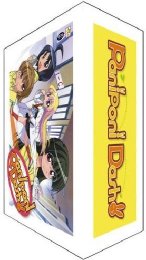








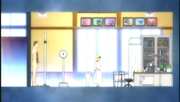







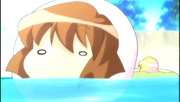
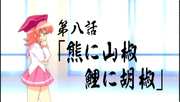
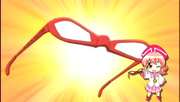












































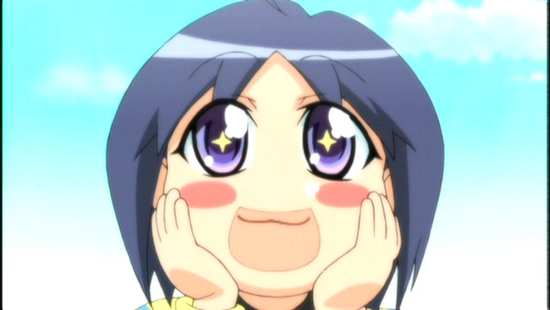








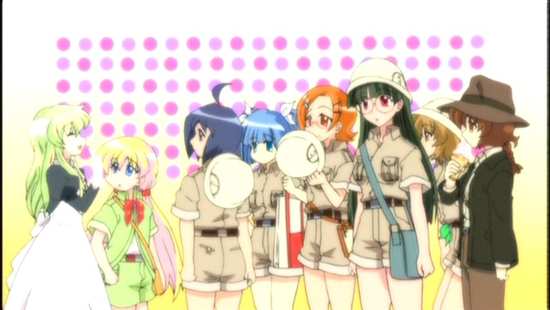


Your Opinions and Comments
The Fast Show was a slow-burner for me too...eventually I fell in love with it, but eventually the repetition wore thin. Much like 'Little Britain'.